Assessment Report: Developing and Implementing Marketing Strategies
VerifiedAdded on 2023/01/16
|16
|3507
|64
Report
AI Summary
This report provides a comprehensive analysis of marketing strategies, covering various aspects essential for business success. It begins with an introduction to the importance of marketing in today's competitive environment. The main body delves into critical factors for developing effective marketing strategies, including political, economic, social, technological, and environmental considerations. It also explores the importance of understanding business capabilities and resources, such as communication, e-business, equipment, financial resources, and human resources. The report examines sources of information for analyzing marketing campaign effectiveness, including marketing metrics and predictive analytics. It further explains comparative market information like benchmarking and competitor analysis. A significant portion of the report focuses on SWOT analysis, identifying strengths, weaknesses, opportunities, and threats within internal and external environments. The report discusses the role of social media, competitor analysis, and promotional activity reports. It also covers market growth analysis, economic factors affecting spending habits, and various aspects of market share. Emerging trends in the TH&E industry, the triple bottom line sustainability concept, and internal/external issues impacting marketing planning are also explored. The report concludes by explaining the purpose of a marketing plan, the importance of staff involvement, and the steps in marketing control, along with examples of reports for analyzing campaign effectiveness.
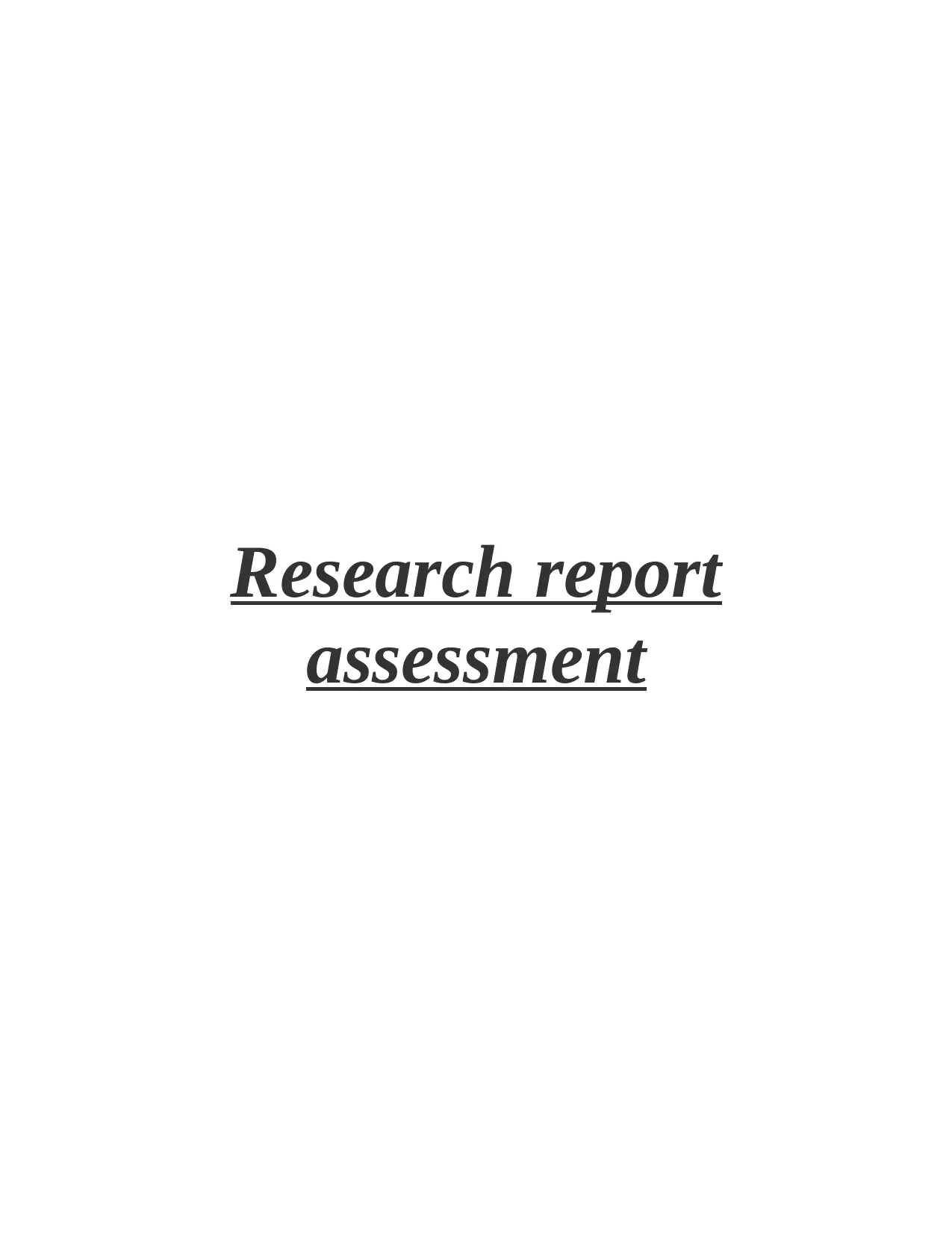
Research report
assessment
assessment
Paraphrase This Document
Need a fresh take? Get an instant paraphrase of this document with our AI Paraphraser
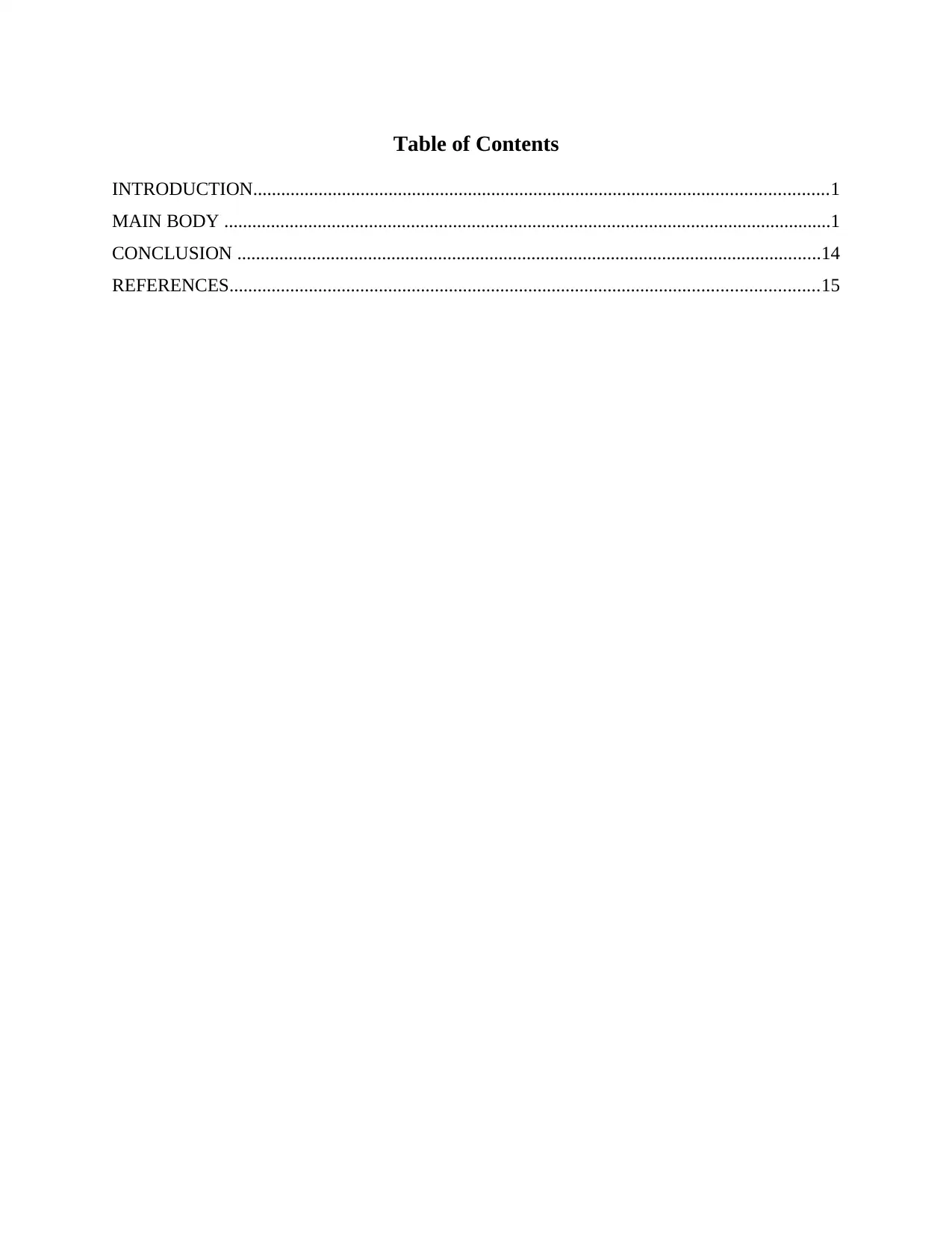
Table of Contents
INTRODUCTION...........................................................................................................................1
MAIN BODY ..................................................................................................................................1
CONCLUSION .............................................................................................................................14
REFERENCES..............................................................................................................................15
INTRODUCTION...........................................................................................................................1
MAIN BODY ..................................................................................................................................1
CONCLUSION .............................................................................................................................14
REFERENCES..............................................................................................................................15
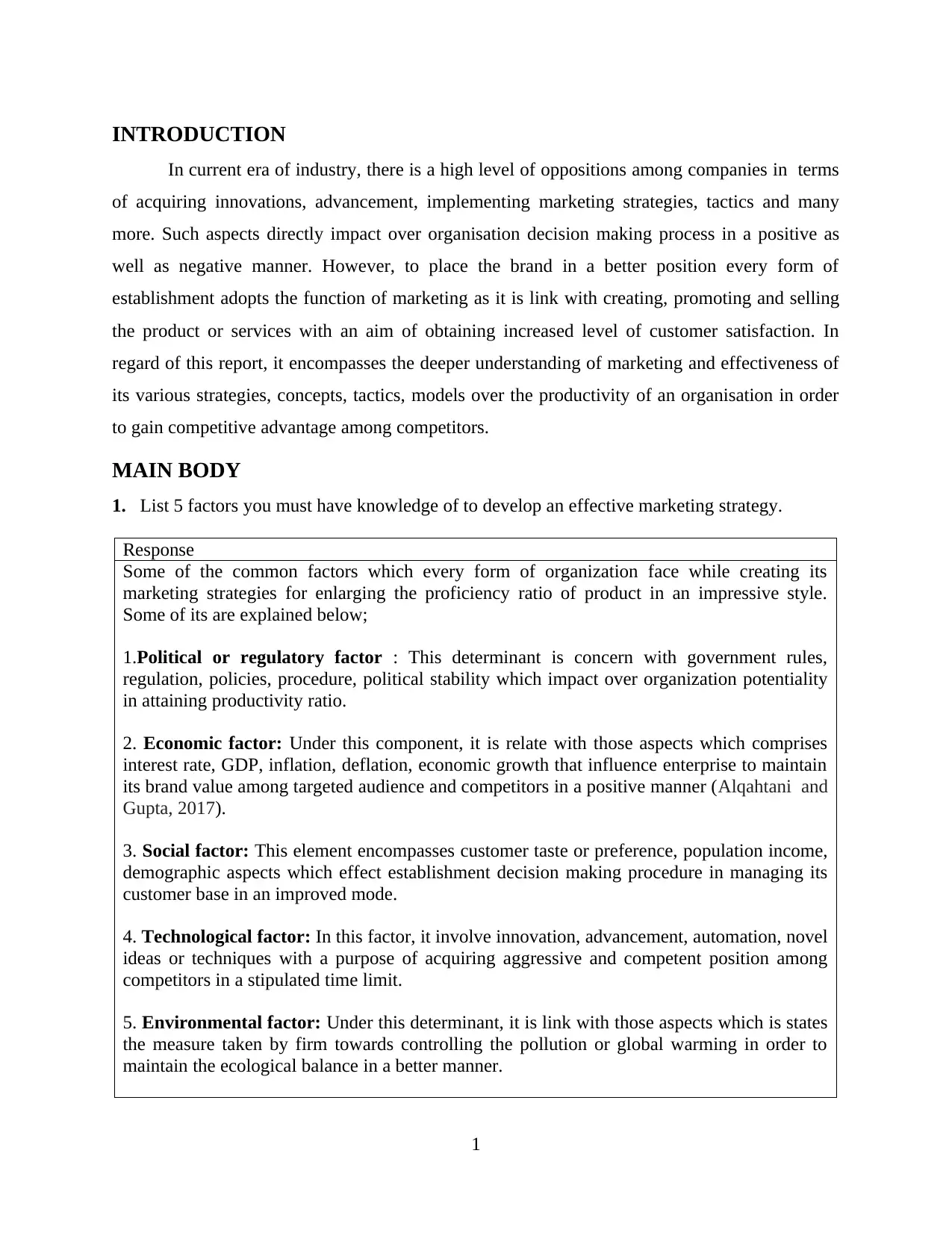
INTRODUCTION
In current era of industry, there is a high level of oppositions among companies in terms
of acquiring innovations, advancement, implementing marketing strategies, tactics and many
more. Such aspects directly impact over organisation decision making process in a positive as
well as negative manner. However, to place the brand in a better position every form of
establishment adopts the function of marketing as it is link with creating, promoting and selling
the product or services with an aim of obtaining increased level of customer satisfaction. In
regard of this report, it encompasses the deeper understanding of marketing and effectiveness of
its various strategies, concepts, tactics, models over the productivity of an organisation in order
to gain competitive advantage among competitors.
MAIN BODY
1. List 5 factors you must have knowledge of to develop an effective marketing strategy.
Response
Some of the common factors which every form of organization face while creating its
marketing strategies for enlarging the proficiency ratio of product in an impressive style.
Some of its are explained below;
1.Political or regulatory factor : This determinant is concern with government rules,
regulation, policies, procedure, political stability which impact over organization potentiality
in attaining productivity ratio.
2. Economic factor: Under this component, it is relate with those aspects which comprises
interest rate, GDP, inflation, deflation, economic growth that influence enterprise to maintain
its brand value among targeted audience and competitors in a positive manner (Alqahtani and
Gupta, 2017).
3. Social factor: This element encompasses customer taste or preference, population income,
demographic aspects which effect establishment decision making procedure in managing its
customer base in an improved mode.
4. Technological factor: In this factor, it involve innovation, advancement, automation, novel
ideas or techniques with a purpose of acquiring aggressive and competent position among
competitors in a stipulated time limit.
5. Environmental factor: Under this determinant, it is link with those aspects which is states
the measure taken by firm towards controlling the pollution or global warming in order to
maintain the ecological balance in a better manner.
1
In current era of industry, there is a high level of oppositions among companies in terms
of acquiring innovations, advancement, implementing marketing strategies, tactics and many
more. Such aspects directly impact over organisation decision making process in a positive as
well as negative manner. However, to place the brand in a better position every form of
establishment adopts the function of marketing as it is link with creating, promoting and selling
the product or services with an aim of obtaining increased level of customer satisfaction. In
regard of this report, it encompasses the deeper understanding of marketing and effectiveness of
its various strategies, concepts, tactics, models over the productivity of an organisation in order
to gain competitive advantage among competitors.
MAIN BODY
1. List 5 factors you must have knowledge of to develop an effective marketing strategy.
Response
Some of the common factors which every form of organization face while creating its
marketing strategies for enlarging the proficiency ratio of product in an impressive style.
Some of its are explained below;
1.Political or regulatory factor : This determinant is concern with government rules,
regulation, policies, procedure, political stability which impact over organization potentiality
in attaining productivity ratio.
2. Economic factor: Under this component, it is relate with those aspects which comprises
interest rate, GDP, inflation, deflation, economic growth that influence enterprise to maintain
its brand value among targeted audience and competitors in a positive manner (Alqahtani and
Gupta, 2017).
3. Social factor: This element encompasses customer taste or preference, population income,
demographic aspects which effect establishment decision making procedure in managing its
customer base in an improved mode.
4. Technological factor: In this factor, it involve innovation, advancement, automation, novel
ideas or techniques with a purpose of acquiring aggressive and competent position among
competitors in a stipulated time limit.
5. Environmental factor: Under this determinant, it is link with those aspects which is states
the measure taken by firm towards controlling the pollution or global warming in order to
maintain the ecological balance in a better manner.
1
⊘ This is a preview!⊘
Do you want full access?
Subscribe today to unlock all pages.

Trusted by 1+ million students worldwide
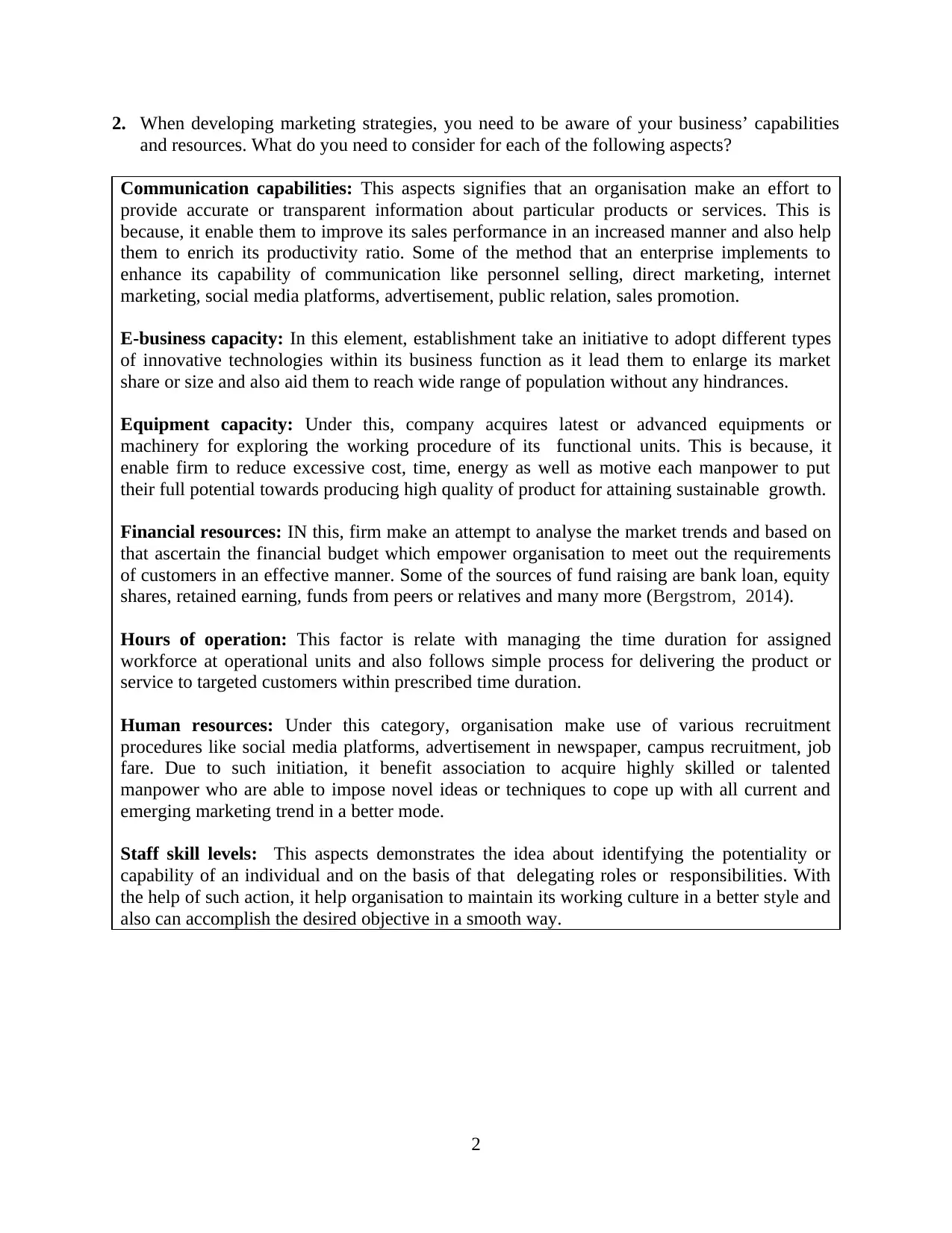
2. When developing marketing strategies, you need to be aware of your business’ capabilities
and resources. What do you need to consider for each of the following aspects?
Communication capabilities: This aspects signifies that an organisation make an effort to
provide accurate or transparent information about particular products or services. This is
because, it enable them to improve its sales performance in an increased manner and also help
them to enrich its productivity ratio. Some of the method that an enterprise implements to
enhance its capability of communication like personnel selling, direct marketing, internet
marketing, social media platforms, advertisement, public relation, sales promotion.
E-business capacity: In this element, establishment take an initiative to adopt different types
of innovative technologies within its business function as it lead them to enlarge its market
share or size and also aid them to reach wide range of population without any hindrances.
Equipment capacity: Under this, company acquires latest or advanced equipments or
machinery for exploring the working procedure of its functional units. This is because, it
enable firm to reduce excessive cost, time, energy as well as motive each manpower to put
their full potential towards producing high quality of product for attaining sustainable growth.
Financial resources: IN this, firm make an attempt to analyse the market trends and based on
that ascertain the financial budget which empower organisation to meet out the requirements
of customers in an effective manner. Some of the sources of fund raising are bank loan, equity
shares, retained earning, funds from peers or relatives and many more (Bergstrom, 2014).
Hours of operation: This factor is relate with managing the time duration for assigned
workforce at operational units and also follows simple process for delivering the product or
service to targeted customers within prescribed time duration.
Human resources: Under this category, organisation make use of various recruitment
procedures like social media platforms, advertisement in newspaper, campus recruitment, job
fare. Due to such initiation, it benefit association to acquire highly skilled or talented
manpower who are able to impose novel ideas or techniques to cope up with all current and
emerging marketing trend in a better mode.
Staff skill levels: This aspects demonstrates the idea about identifying the potentiality or
capability of an individual and on the basis of that delegating roles or responsibilities. With
the help of such action, it help organisation to maintain its working culture in a better style and
also can accomplish the desired objective in a smooth way.
2
and resources. What do you need to consider for each of the following aspects?
Communication capabilities: This aspects signifies that an organisation make an effort to
provide accurate or transparent information about particular products or services. This is
because, it enable them to improve its sales performance in an increased manner and also help
them to enrich its productivity ratio. Some of the method that an enterprise implements to
enhance its capability of communication like personnel selling, direct marketing, internet
marketing, social media platforms, advertisement, public relation, sales promotion.
E-business capacity: In this element, establishment take an initiative to adopt different types
of innovative technologies within its business function as it lead them to enlarge its market
share or size and also aid them to reach wide range of population without any hindrances.
Equipment capacity: Under this, company acquires latest or advanced equipments or
machinery for exploring the working procedure of its functional units. This is because, it
enable firm to reduce excessive cost, time, energy as well as motive each manpower to put
their full potential towards producing high quality of product for attaining sustainable growth.
Financial resources: IN this, firm make an attempt to analyse the market trends and based on
that ascertain the financial budget which empower organisation to meet out the requirements
of customers in an effective manner. Some of the sources of fund raising are bank loan, equity
shares, retained earning, funds from peers or relatives and many more (Bergstrom, 2014).
Hours of operation: This factor is relate with managing the time duration for assigned
workforce at operational units and also follows simple process for delivering the product or
service to targeted customers within prescribed time duration.
Human resources: Under this category, organisation make use of various recruitment
procedures like social media platforms, advertisement in newspaper, campus recruitment, job
fare. Due to such initiation, it benefit association to acquire highly skilled or talented
manpower who are able to impose novel ideas or techniques to cope up with all current and
emerging marketing trend in a better mode.
Staff skill levels: This aspects demonstrates the idea about identifying the potentiality or
capability of an individual and on the basis of that delegating roles or responsibilities. With
the help of such action, it help organisation to maintain its working culture in a better style and
also can accomplish the desired objective in a smooth way.
2
Paraphrase This Document
Need a fresh take? Get an instant paraphrase of this document with our AI Paraphraser
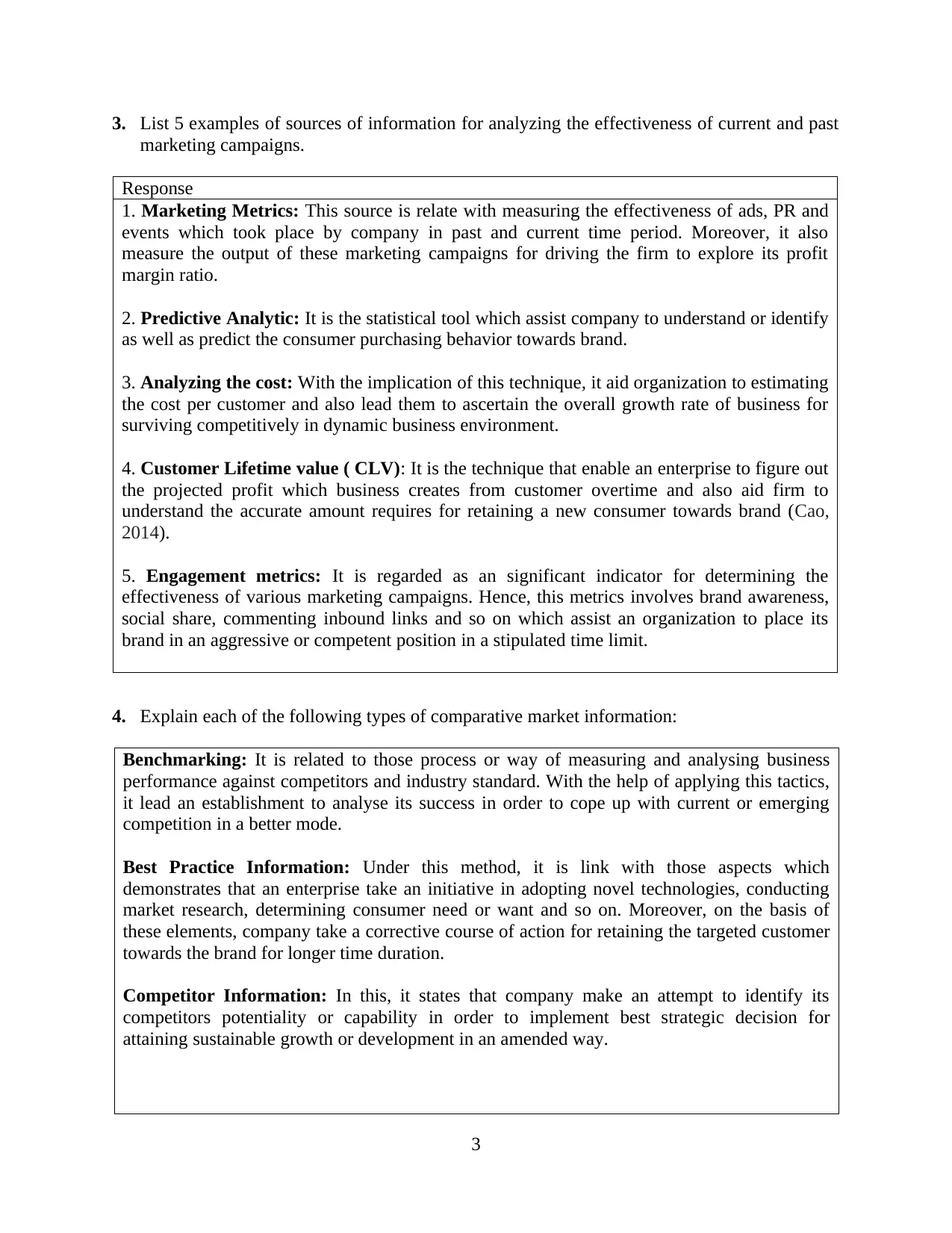
3. List 5 examples of sources of information for analyzing the effectiveness of current and past
marketing campaigns.
Response
1. Marketing Metrics: This source is relate with measuring the effectiveness of ads, PR and
events which took place by company in past and current time period. Moreover, it also
measure the output of these marketing campaigns for driving the firm to explore its profit
margin ratio.
2. Predictive Analytic: It is the statistical tool which assist company to understand or identify
as well as predict the consumer purchasing behavior towards brand.
3. Analyzing the cost: With the implication of this technique, it aid organization to estimating
the cost per customer and also lead them to ascertain the overall growth rate of business for
surviving competitively in dynamic business environment.
4. Customer Lifetime value ( CLV): It is the technique that enable an enterprise to figure out
the projected profit which business creates from customer overtime and also aid firm to
understand the accurate amount requires for retaining a new consumer towards brand (Cao,
2014).
5. Engagement metrics: It is regarded as an significant indicator for determining the
effectiveness of various marketing campaigns. Hence, this metrics involves brand awareness,
social share, commenting inbound links and so on which assist an organization to place its
brand in an aggressive or competent position in a stipulated time limit.
4. Explain each of the following types of comparative market information:
Benchmarking: It is related to those process or way of measuring and analysing business
performance against competitors and industry standard. With the help of applying this tactics,
it lead an establishment to analyse its success in order to cope up with current or emerging
competition in a better mode.
Best Practice Information: Under this method, it is link with those aspects which
demonstrates that an enterprise take an initiative in adopting novel technologies, conducting
market research, determining consumer need or want and so on. Moreover, on the basis of
these elements, company take a corrective course of action for retaining the targeted customer
towards the brand for longer time duration.
Competitor Information: In this, it states that company make an attempt to identify its
competitors potentiality or capability in order to implement best strategic decision for
attaining sustainable growth or development in an amended way.
3
marketing campaigns.
Response
1. Marketing Metrics: This source is relate with measuring the effectiveness of ads, PR and
events which took place by company in past and current time period. Moreover, it also
measure the output of these marketing campaigns for driving the firm to explore its profit
margin ratio.
2. Predictive Analytic: It is the statistical tool which assist company to understand or identify
as well as predict the consumer purchasing behavior towards brand.
3. Analyzing the cost: With the implication of this technique, it aid organization to estimating
the cost per customer and also lead them to ascertain the overall growth rate of business for
surviving competitively in dynamic business environment.
4. Customer Lifetime value ( CLV): It is the technique that enable an enterprise to figure out
the projected profit which business creates from customer overtime and also aid firm to
understand the accurate amount requires for retaining a new consumer towards brand (Cao,
2014).
5. Engagement metrics: It is regarded as an significant indicator for determining the
effectiveness of various marketing campaigns. Hence, this metrics involves brand awareness,
social share, commenting inbound links and so on which assist an organization to place its
brand in an aggressive or competent position in a stipulated time limit.
4. Explain each of the following types of comparative market information:
Benchmarking: It is related to those process or way of measuring and analysing business
performance against competitors and industry standard. With the help of applying this tactics,
it lead an establishment to analyse its success in order to cope up with current or emerging
competition in a better mode.
Best Practice Information: Under this method, it is link with those aspects which
demonstrates that an enterprise take an initiative in adopting novel technologies, conducting
market research, determining consumer need or want and so on. Moreover, on the basis of
these elements, company take a corrective course of action for retaining the targeted customer
towards the brand for longer time duration.
Competitor Information: In this, it states that company make an attempt to identify its
competitors potentiality or capability in order to implement best strategic decision for
attaining sustainable growth or development in an amended way.
3
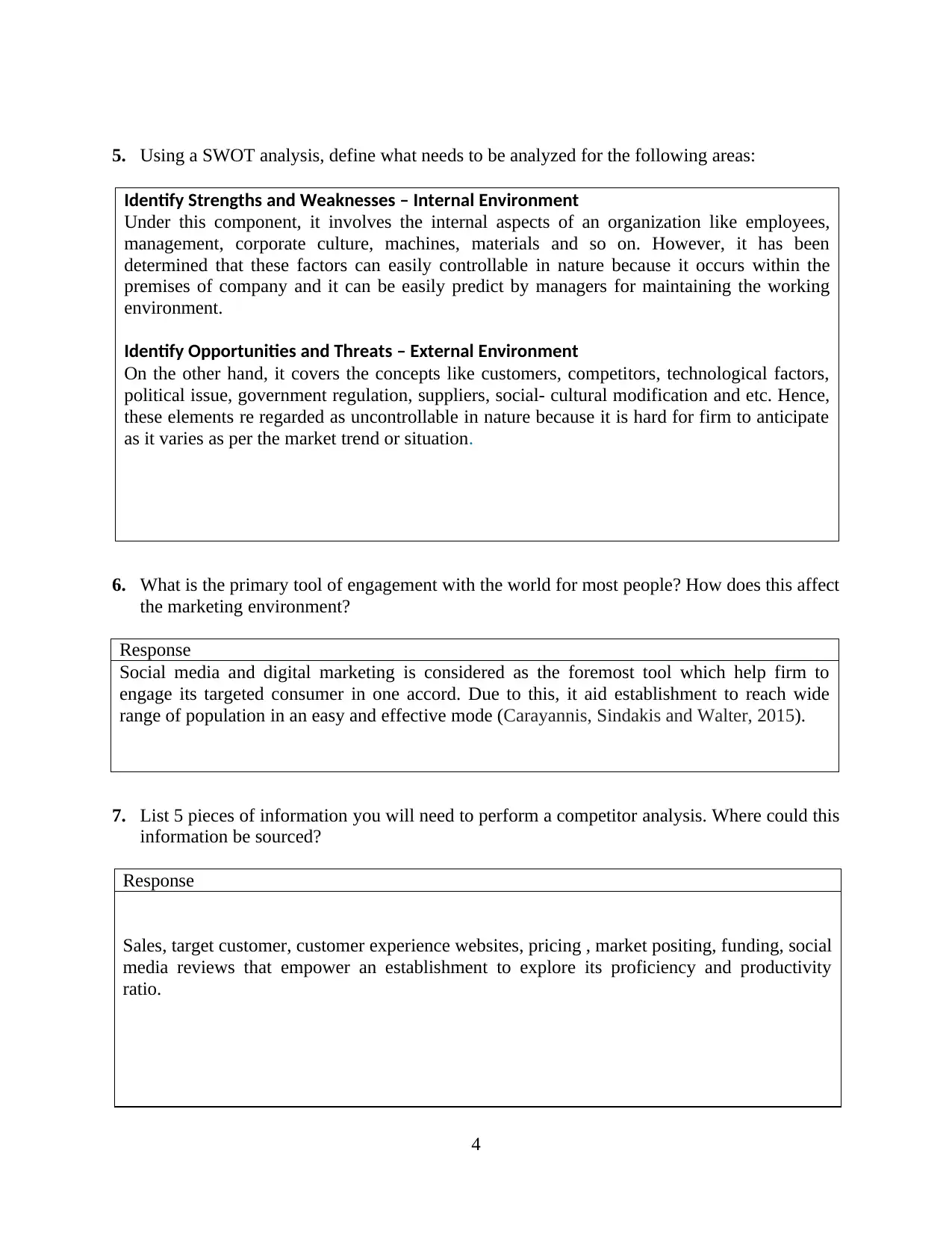
5. Using a SWOT analysis, define what needs to be analyzed for the following areas:
Identify Strengths and Weaknesses – Internal Environment
Under this component, it involves the internal aspects of an organization like employees,
management, corporate culture, machines, materials and so on. However, it has been
determined that these factors can easily controllable in nature because it occurs within the
premises of company and it can be easily predict by managers for maintaining the working
environment.
Identify Opportunities and Threats – External Environment
On the other hand, it covers the concepts like customers, competitors, technological factors,
political issue, government regulation, suppliers, social- cultural modification and etc. Hence,
these elements re regarded as uncontrollable in nature because it is hard for firm to anticipate
as it varies as per the market trend or situation.
6. What is the primary tool of engagement with the world for most people? How does this affect
the marketing environment?
Response
Social media and digital marketing is considered as the foremost tool which help firm to
engage its targeted consumer in one accord. Due to this, it aid establishment to reach wide
range of population in an easy and effective mode (Carayannis, Sindakis and Walter, 2015).
7. List 5 pieces of information you will need to perform a competitor analysis. Where could this
information be sourced?
Response
Sales, target customer, customer experience websites, pricing , market positing, funding, social
media reviews that empower an establishment to explore its proficiency and productivity
ratio.
4
Identify Strengths and Weaknesses – Internal Environment
Under this component, it involves the internal aspects of an organization like employees,
management, corporate culture, machines, materials and so on. However, it has been
determined that these factors can easily controllable in nature because it occurs within the
premises of company and it can be easily predict by managers for maintaining the working
environment.
Identify Opportunities and Threats – External Environment
On the other hand, it covers the concepts like customers, competitors, technological factors,
political issue, government regulation, suppliers, social- cultural modification and etc. Hence,
these elements re regarded as uncontrollable in nature because it is hard for firm to anticipate
as it varies as per the market trend or situation.
6. What is the primary tool of engagement with the world for most people? How does this affect
the marketing environment?
Response
Social media and digital marketing is considered as the foremost tool which help firm to
engage its targeted consumer in one accord. Due to this, it aid establishment to reach wide
range of population in an easy and effective mode (Carayannis, Sindakis and Walter, 2015).
7. List 5 pieces of information you will need to perform a competitor analysis. Where could this
information be sourced?
Response
Sales, target customer, customer experience websites, pricing , market positing, funding, social
media reviews that empower an establishment to explore its proficiency and productivity
ratio.
4
⊘ This is a preview!⊘
Do you want full access?
Subscribe today to unlock all pages.

Trusted by 1+ million students worldwide
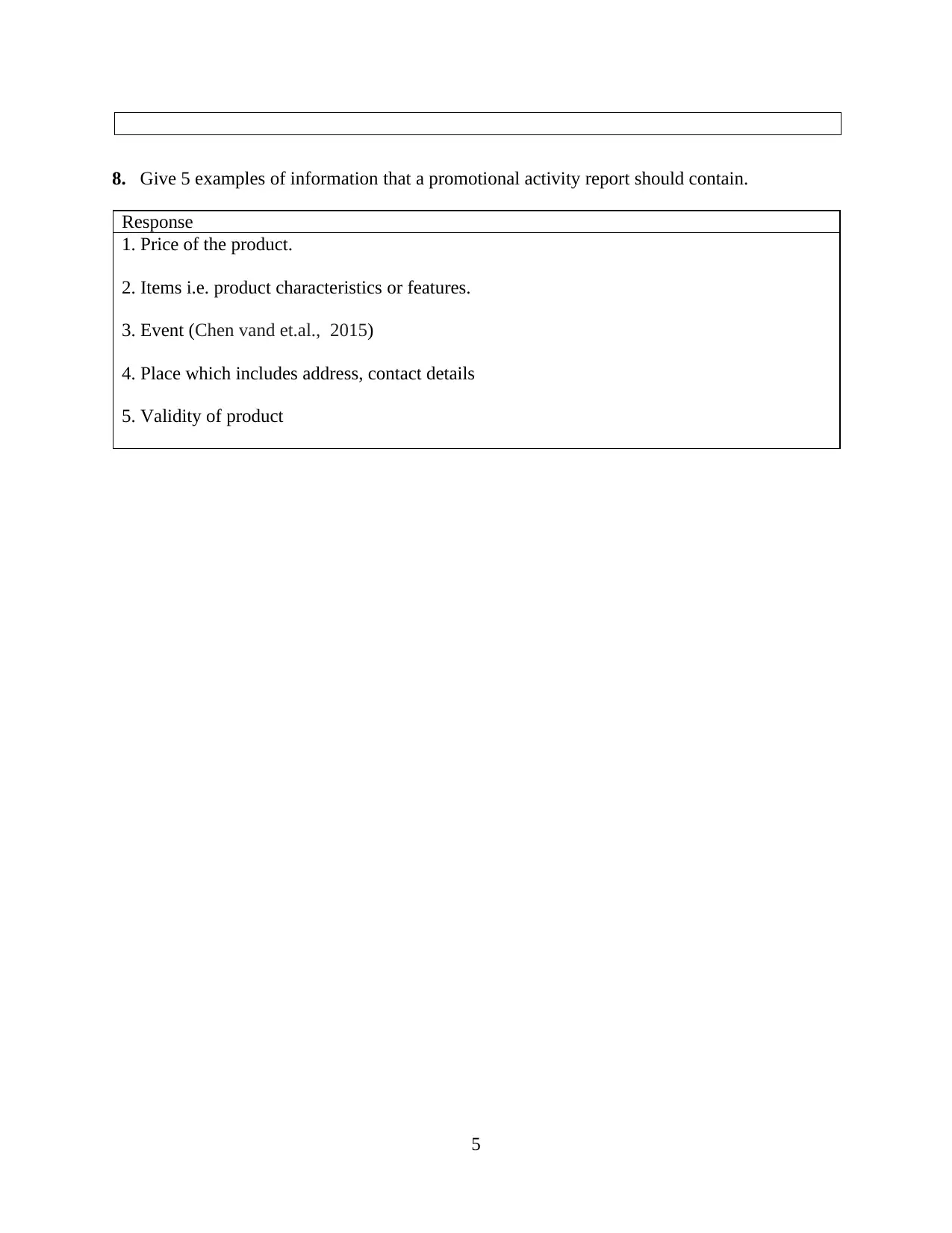
8. Give 5 examples of information that a promotional activity report should contain.
Response
1. Price of the product.
2. Items i.e. product characteristics or features.
3. Event (Chen vand et.al., 2015)
4. Place which includes address, contact details
5. Validity of product
5
Response
1. Price of the product.
2. Items i.e. product characteristics or features.
3. Event (Chen vand et.al., 2015)
4. Place which includes address, contact details
5. Validity of product
5
Paraphrase This Document
Need a fresh take? Get an instant paraphrase of this document with our AI Paraphraser
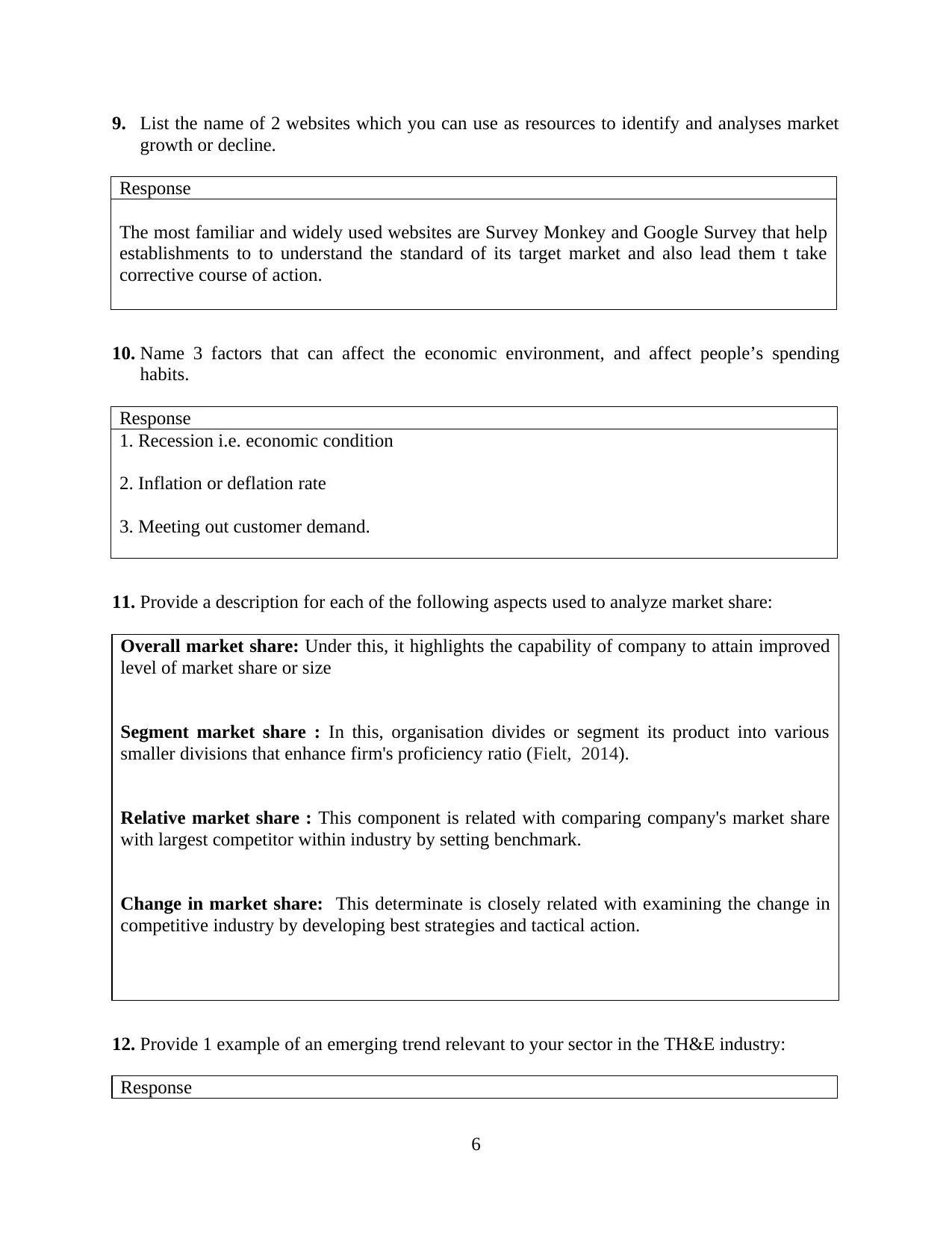
9. List the name of 2 websites which you can use as resources to identify and analyses market
growth or decline.
Response
The most familiar and widely used websites are Survey Monkey and Google Survey that help
establishments to to understand the standard of its target market and also lead them t take
corrective course of action.
10. Name 3 factors that can affect the economic environment, and affect people’s spending
habits.
Response
1. Recession i.e. economic condition
2. Inflation or deflation rate
3. Meeting out customer demand.
11. Provide a description for each of the following aspects used to analyze market share:
Overall market share: Under this, it highlights the capability of company to attain improved
level of market share or size
Segment market share : In this, organisation divides or segment its product into various
smaller divisions that enhance firm's proficiency ratio (Fielt, 2014).
Relative market share : This component is related with comparing company's market share
with largest competitor within industry by setting benchmark.
Change in market share: This determinate is closely related with examining the change in
competitive industry by developing best strategies and tactical action.
12. Provide 1 example of an emerging trend relevant to your sector in the TH&E industry:
Response
6
growth or decline.
Response
The most familiar and widely used websites are Survey Monkey and Google Survey that help
establishments to to understand the standard of its target market and also lead them t take
corrective course of action.
10. Name 3 factors that can affect the economic environment, and affect people’s spending
habits.
Response
1. Recession i.e. economic condition
2. Inflation or deflation rate
3. Meeting out customer demand.
11. Provide a description for each of the following aspects used to analyze market share:
Overall market share: Under this, it highlights the capability of company to attain improved
level of market share or size
Segment market share : In this, organisation divides or segment its product into various
smaller divisions that enhance firm's proficiency ratio (Fielt, 2014).
Relative market share : This component is related with comparing company's market share
with largest competitor within industry by setting benchmark.
Change in market share: This determinate is closely related with examining the change in
competitive industry by developing best strategies and tactical action.
12. Provide 1 example of an emerging trend relevant to your sector in the TH&E industry:
Response
6
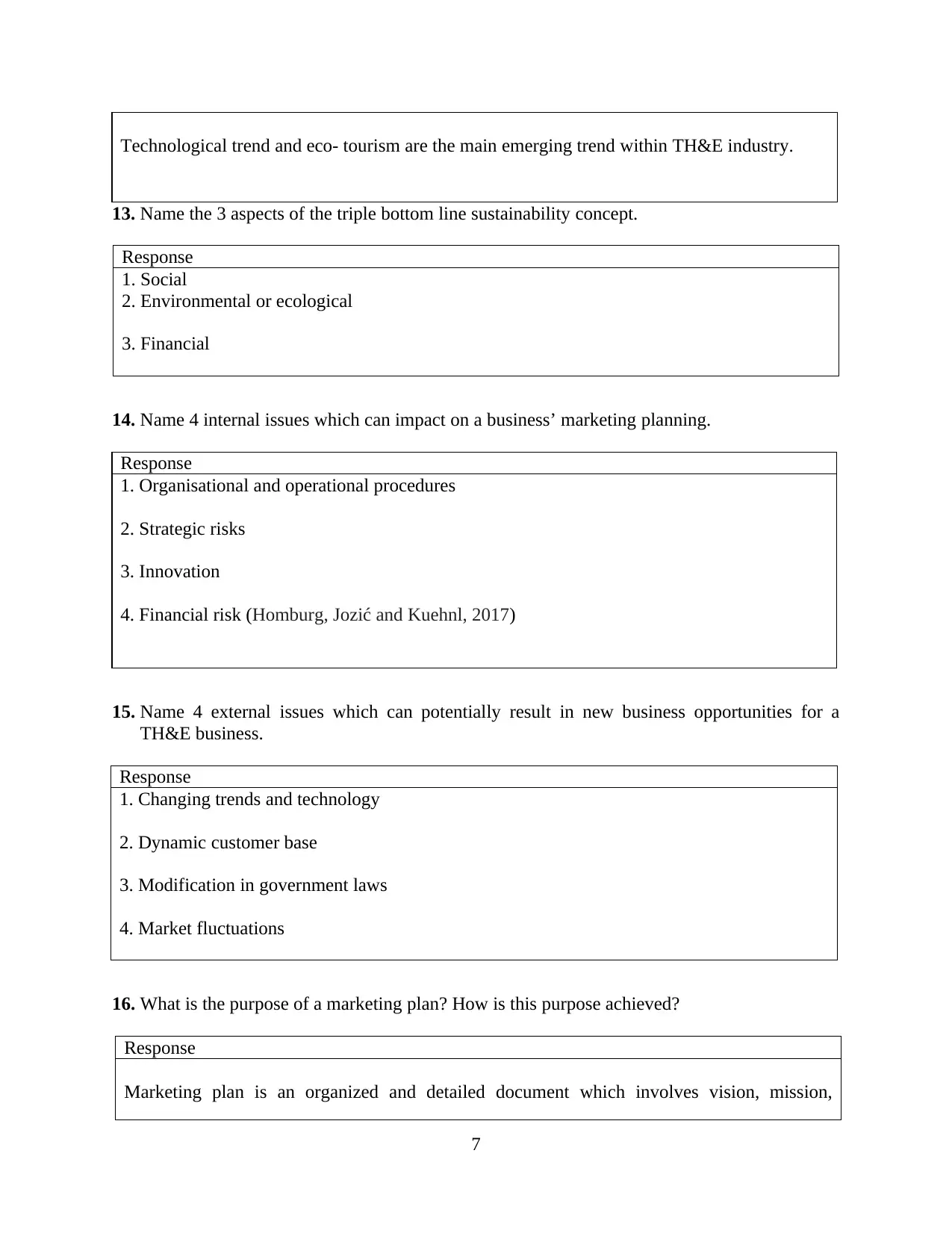
Technological trend and eco- tourism are the main emerging trend within TH&E industry.
13. Name the 3 aspects of the triple bottom line sustainability concept.
Response
1. Social
2. Environmental or ecological
3. Financial
14. Name 4 internal issues which can impact on a business’ marketing planning.
Response
1. Organisational and operational procedures
2. Strategic risks
3. Innovation
4. Financial risk (Homburg, Jozić and Kuehnl, 2017)
15. Name 4 external issues which can potentially result in new business opportunities for a
TH&E business.
Response
1. Changing trends and technology
2. Dynamic customer base
3. Modification in government laws
4. Market fluctuations
16. What is the purpose of a marketing plan? How is this purpose achieved?
Response
Marketing plan is an organized and detailed document which involves vision, mission,
7
13. Name the 3 aspects of the triple bottom line sustainability concept.
Response
1. Social
2. Environmental or ecological
3. Financial
14. Name 4 internal issues which can impact on a business’ marketing planning.
Response
1. Organisational and operational procedures
2. Strategic risks
3. Innovation
4. Financial risk (Homburg, Jozić and Kuehnl, 2017)
15. Name 4 external issues which can potentially result in new business opportunities for a
TH&E business.
Response
1. Changing trends and technology
2. Dynamic customer base
3. Modification in government laws
4. Market fluctuations
16. What is the purpose of a marketing plan? How is this purpose achieved?
Response
Marketing plan is an organized and detailed document which involves vision, mission,
7
⊘ This is a preview!⊘
Do you want full access?
Subscribe today to unlock all pages.

Trusted by 1+ million students worldwide
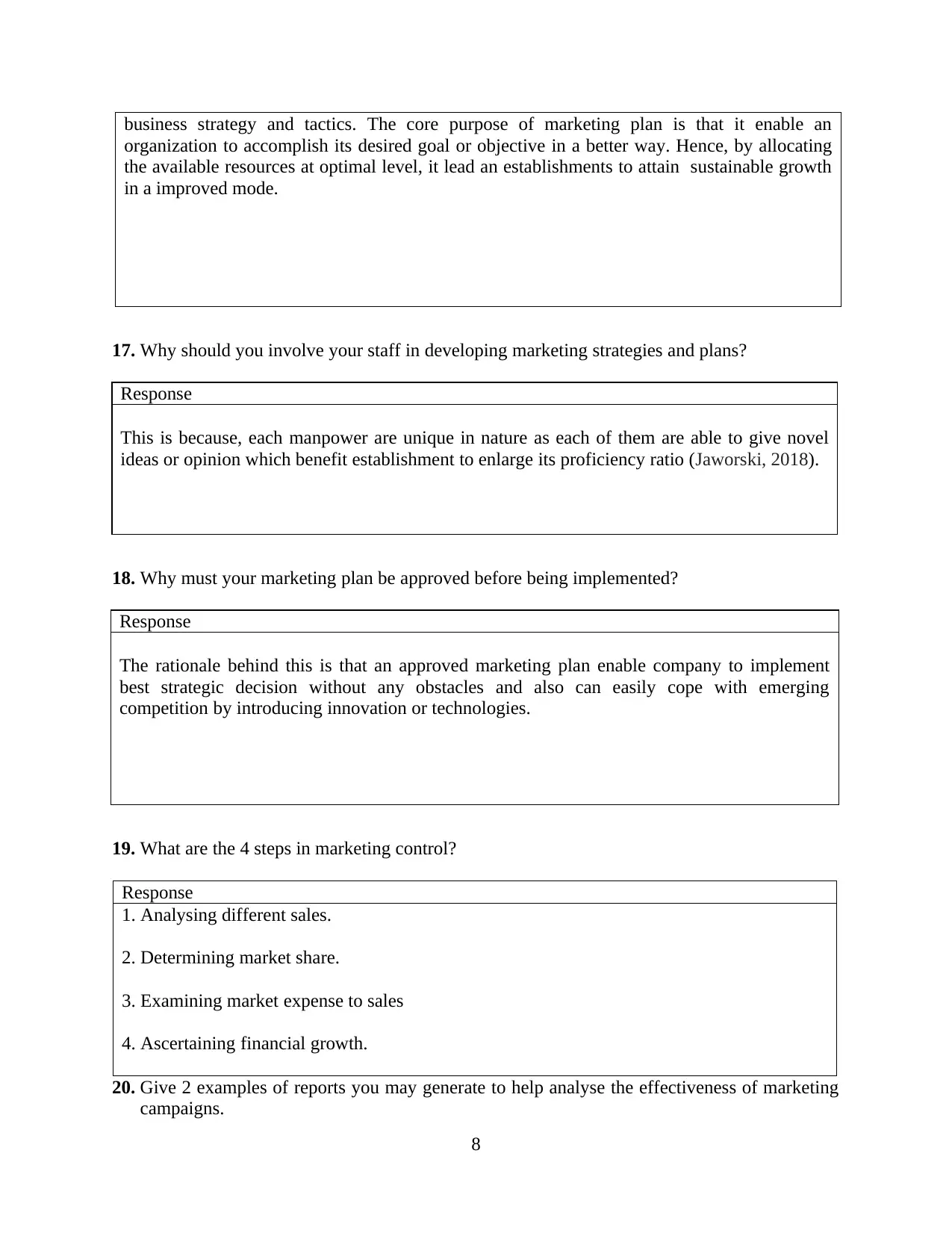
business strategy and tactics. The core purpose of marketing plan is that it enable an
organization to accomplish its desired goal or objective in a better way. Hence, by allocating
the available resources at optimal level, it lead an establishments to attain sustainable growth
in a improved mode.
17. Why should you involve your staff in developing marketing strategies and plans?
Response
This is because, each manpower are unique in nature as each of them are able to give novel
ideas or opinion which benefit establishment to enlarge its proficiency ratio (Jaworski, 2018).
18. Why must your marketing plan be approved before being implemented?
Response
The rationale behind this is that an approved marketing plan enable company to implement
best strategic decision without any obstacles and also can easily cope with emerging
competition by introducing innovation or technologies.
19. What are the 4 steps in marketing control?
Response
1. Analysing different sales.
2. Determining market share.
3. Examining market expense to sales
4. Ascertaining financial growth.
20. Give 2 examples of reports you may generate to help analyse the effectiveness of marketing
campaigns.
8
organization to accomplish its desired goal or objective in a better way. Hence, by allocating
the available resources at optimal level, it lead an establishments to attain sustainable growth
in a improved mode.
17. Why should you involve your staff in developing marketing strategies and plans?
Response
This is because, each manpower are unique in nature as each of them are able to give novel
ideas or opinion which benefit establishment to enlarge its proficiency ratio (Jaworski, 2018).
18. Why must your marketing plan be approved before being implemented?
Response
The rationale behind this is that an approved marketing plan enable company to implement
best strategic decision without any obstacles and also can easily cope with emerging
competition by introducing innovation or technologies.
19. What are the 4 steps in marketing control?
Response
1. Analysing different sales.
2. Determining market share.
3. Examining market expense to sales
4. Ascertaining financial growth.
20. Give 2 examples of reports you may generate to help analyse the effectiveness of marketing
campaigns.
8
Paraphrase This Document
Need a fresh take? Get an instant paraphrase of this document with our AI Paraphraser
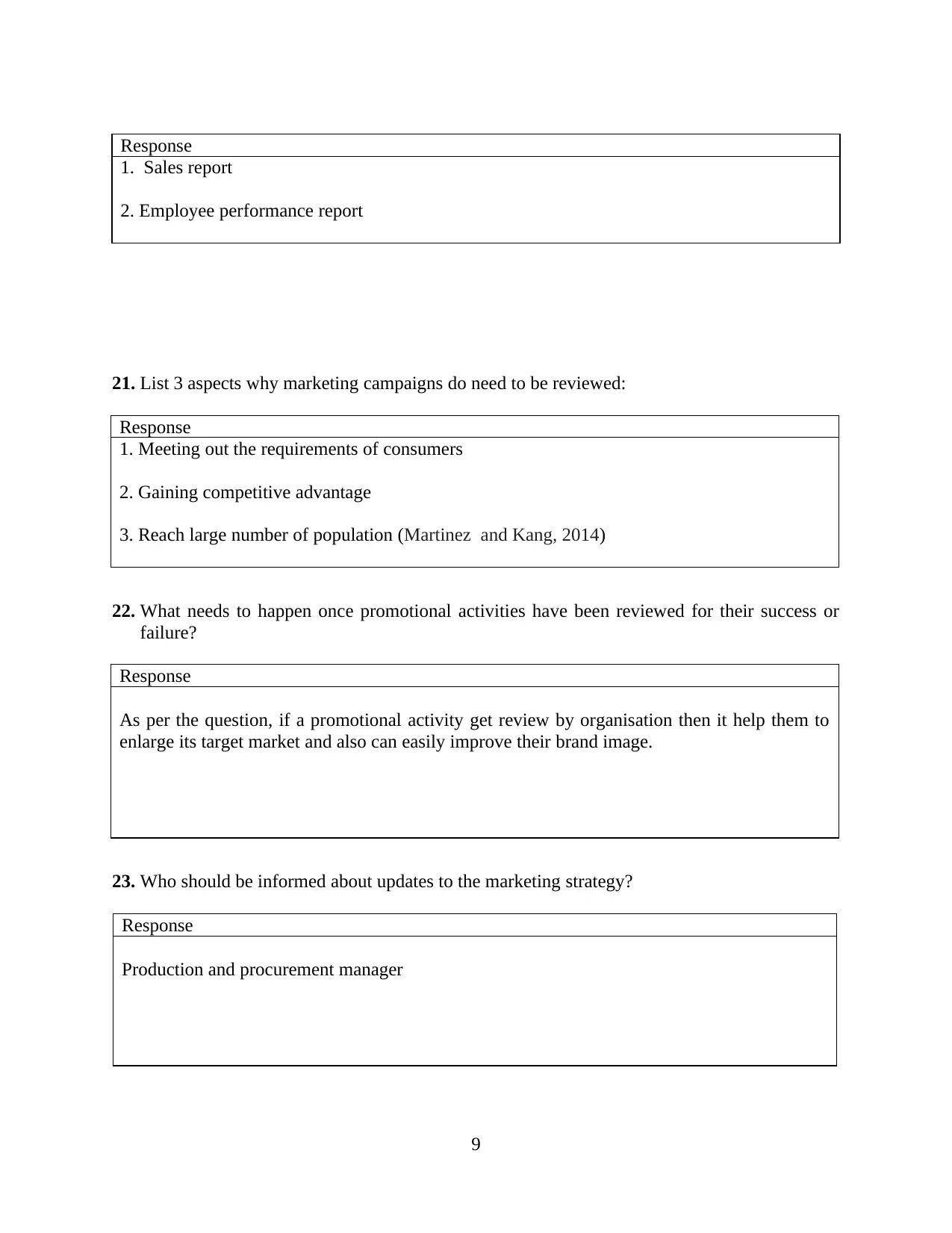
Response
1. Sales report
2. Employee performance report
21. List 3 aspects why marketing campaigns do need to be reviewed:
Response
1. Meeting out the requirements of consumers
2. Gaining competitive advantage
3. Reach large number of population (Martinez and Kang, 2014)
22. What needs to happen once promotional activities have been reviewed for their success or
failure?
Response
As per the question, if a promotional activity get review by organisation then it help them to
enlarge its target market and also can easily improve their brand image.
23. Who should be informed about updates to the marketing strategy?
Response
Production and procurement manager
9
1. Sales report
2. Employee performance report
21. List 3 aspects why marketing campaigns do need to be reviewed:
Response
1. Meeting out the requirements of consumers
2. Gaining competitive advantage
3. Reach large number of population (Martinez and Kang, 2014)
22. What needs to happen once promotional activities have been reviewed for their success or
failure?
Response
As per the question, if a promotional activity get review by organisation then it help them to
enlarge its target market and also can easily improve their brand image.
23. Who should be informed about updates to the marketing strategy?
Response
Production and procurement manager
9
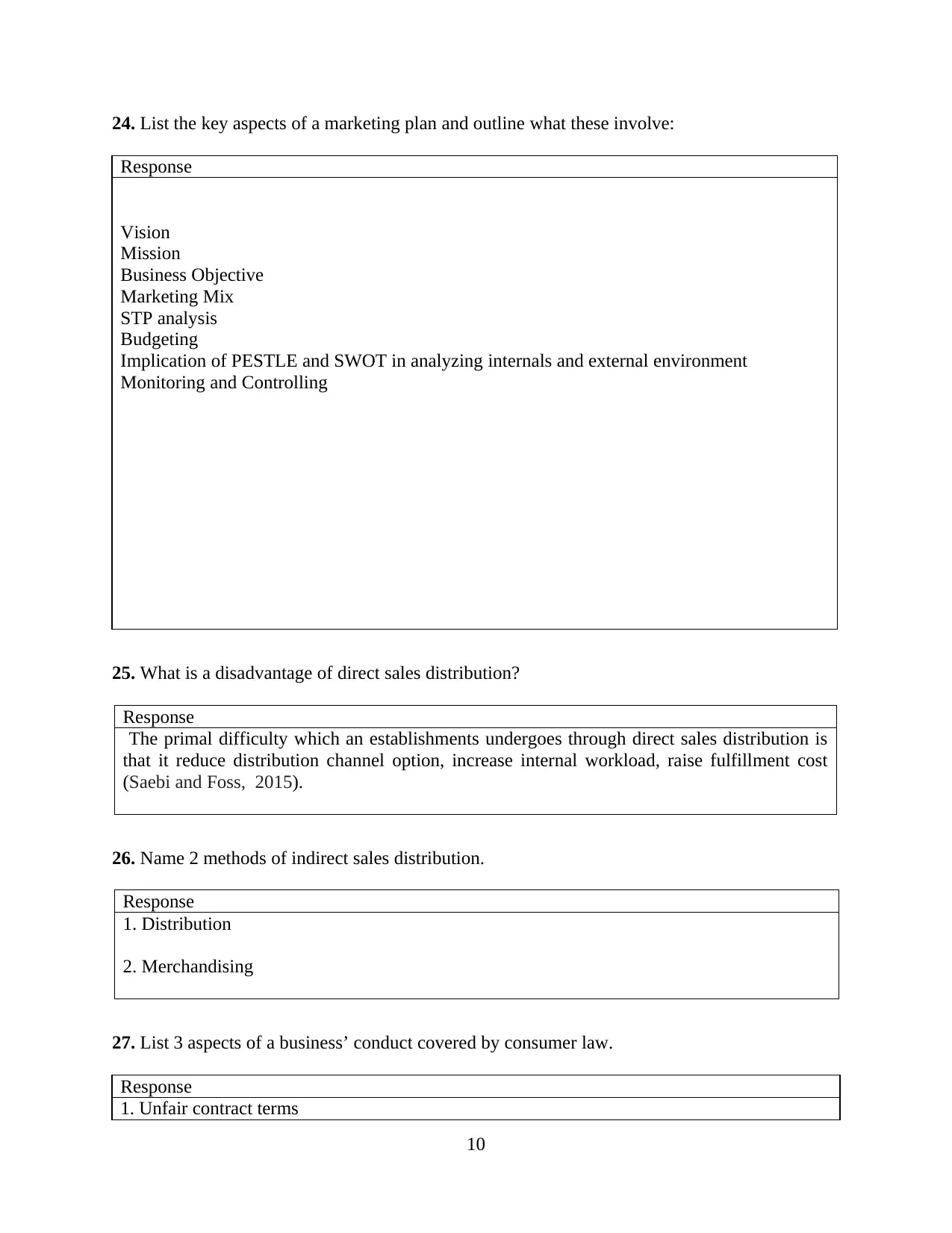
24. List the key aspects of a marketing plan and outline what these involve:
Response
Vision
Mission
Business Objective
Marketing Mix
STP analysis
Budgeting
Implication of PESTLE and SWOT in analyzing internals and external environment
Monitoring and Controlling
25. What is a disadvantage of direct sales distribution?
Response
The primal difficulty which an establishments undergoes through direct sales distribution is
that it reduce distribution channel option, increase internal workload, raise fulfillment cost
(Saebi and Foss, 2015).
26. Name 2 methods of indirect sales distribution.
Response
1. Distribution
2. Merchandising
27. List 3 aspects of a business’ conduct covered by consumer law.
Response
1. Unfair contract terms
10
Response
Vision
Mission
Business Objective
Marketing Mix
STP analysis
Budgeting
Implication of PESTLE and SWOT in analyzing internals and external environment
Monitoring and Controlling
25. What is a disadvantage of direct sales distribution?
Response
The primal difficulty which an establishments undergoes through direct sales distribution is
that it reduce distribution channel option, increase internal workload, raise fulfillment cost
(Saebi and Foss, 2015).
26. Name 2 methods of indirect sales distribution.
Response
1. Distribution
2. Merchandising
27. List 3 aspects of a business’ conduct covered by consumer law.
Response
1. Unfair contract terms
10
⊘ This is a preview!⊘
Do you want full access?
Subscribe today to unlock all pages.

Trusted by 1+ million students worldwide
1 out of 16
Related Documents
Your All-in-One AI-Powered Toolkit for Academic Success.
+13062052269
info@desklib.com
Available 24*7 on WhatsApp / Email
![[object Object]](/_next/static/media/star-bottom.7253800d.svg)
Unlock your academic potential
Copyright © 2020–2025 A2Z Services. All Rights Reserved. Developed and managed by ZUCOL.





